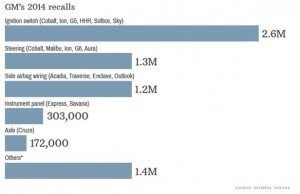Imagine you have a 10 page paper due at midnight and you’re almost finished, you are starting to feel relieved and BOOM! Your computer crashes! What do you do? Who do you blame for it? I am sure many of your first reactions after crying all night is to take it back to where you purchased it from, and ask them to diagnose the problem. You don’t actually care what the problem is and who’s at fault, you just want it fixed. But what happens when the situation is more complex and deals with a defect that cost someone their life? Do we pay attention now?
Last Monday, General Motors death toll rose to 21 people resulting from a defect in the ignition switch on older model cars. Although General Motors knew of the ignition switch defect almost a decade ago, they did not take action until recently. The ignition slips to off or accessory, cutting off power to the air bags so they will not deploy during a crash and also cutting electronic steering and braking, causing people to veer off the road. We see that when operation management fails, companies have to have recovery strategies in place. General Motors hired compensation expert Kenneth Fienberg who decide that all passengers, pedestrians, and bystanders who were injured in result to the crash could receive a settlement. In addition, General Motors CEO; Marry Barra fired 15 employees who knew of the defect. Although a great start to reprimanding those who knew of the situation, the company is still being fined $ 35 million by the U.S. Transportation Department for failing to report the need for a recall have an estimated payout of $400 million to compensate victims. Their recovery strategies could have been prevented if their operations team considered ethics.
This reminded me of our paper puppet exercise. Our assembly line created 20 puppets, where process one failed to mention defects in the original paper. As the defected paper continued through the assembly line it was cut, folded, and colored where the defect was not as noticeable anymore. Once it reached our inspection line, many of them did notice. Yes many of us laughed when we found out our assembly line continued to use them, but I don’t think we would laugh if we knew this case could possibly be the outcome.
Who do we blame for the death of these victims? I am sure many of us would say General Motors. Why did they withhold so much information from the public? Why didn’t the National Highway Safety Administration take these claims more serious and open an investigation? Operations management failed, their strategic decision steps failed, and their quality management team did not ensure safety like it should have. As average citizens in society we often accept the answer that something is fixed, but do not care for all the details. This plays into why quality control often lacks ethical standards. We too have to do better.
Who do you blame?
Sources:
G.M Timeline of Problems and Who Knew
Nissan Factory Life: How Cars are Built



I like how you have tied in our class to a real world example of failed operations management. It was very interesting seeing your comparison and I think you are right. An environment must be fostered such that it will allow individual workers to stop the assembly line to address manufacturing issues that arise. This will lead to better overall quality. In our class the workers were under the impression they could not talk and were just supposed to do their jobs as quickly as possible. This approach lead to problems. With the defective paper, for example, the QA people in our class did not notice the markings on the paper because it had been folded over on the inside. If one of the first workers (1 or 2) mentioned it then that puppet might have not gotten through. This would have led to higher quality. This is the same idea that many car manufacturers are adopting now (I know Toyota employs this) where assembly line workers can stop the assembly line when they see a manufacturing defect and are able to fix the issue right there rather than try and fix it after many more steps in the process where it might be much more expensive to fix or catch. I appreciated reading your post and it caused me to think more about how our class relates to the real world.
Like grzegorz30123f14, I immediately thought about the paper puppet activity we did in class. I believe that ultimately general motors is to blame for hiring some employees that did not care about their role in the assembly of these cars. If the employees saw something wrong in the ignition switch, they should have reported it. Instead, I’m assuming they decided that it was someone else’s problem or that someone else would take care of it. It’s depressing to know that due to possible lack of caring in employee’s, general motors customer’s had to pay a deadly price.